Day 3, the final day, of a long weekend of tours today. It was an early start, as we were heading up to Snettisham for the Wader Spectacular on the Wash. It was well worth getting up for!
Driving along the roads on the way there early morning, we flushed lots of birds from the edges of the tarmac – lots of Woodpigeons are to be expected at that time of the morning, a couple of Stock Doves were nice to see, and the ubiquitous Red-legged Partridges. More of a surprise were a single Guineafowl and a Peacock – both presumably having wandered out of someone’s garden! As we got to Snettisham, we stopped to look at a Turtle Dove preening on the wires.
As soon as we got up onto the seawall, we could see a big flock of waders flying round, several thousand strong, before dropping back down onto the mud. Scanning through the massed hordes we could see the wide variety of birds gathering on the Wash. The biggest numbers were Knot and Bar-tailed Godwits, with smaller numbers of Black-tailed Godwits as well. There were also very large flocks of Oystercatchers and Curlew.
With the tide coming in fast, it was amazing to watch the movement of the flocks. Birds would try to stand still, but eventually get moved by the rising water. As they did so, the whole flock would shift, the birds from the edge walking up onto drier ground. From a distance, it was like watching a pool of fluid – it seemed to flow across the mud.
 The vast hordes of waders gathering on the mud as the tide rose
The vast hordes of waders gathering on the mud as the tide rose
Closer in, there were flocks of smaller waders – Dunlin, Sanderling and Ringed Plover. They were still feeding actively ahead of the rising tide, running around on the mud or along the water’s edge. As the water filled the muddy creeks, several Common Sandpipers flew round calling.
However, the real highlight was the stunning display when they all flew. Today, it was a young Marsh Harrier quartering the vegetation at the edge of the mud which kept spooking them. All the waders would erupt into the air and swirl round in vast flocks, constantly changing shape as they did so. An awesome sight!
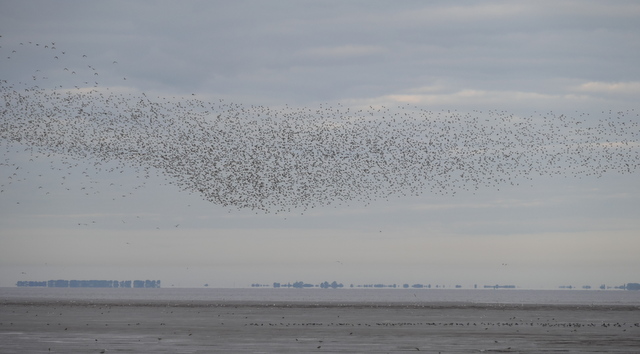
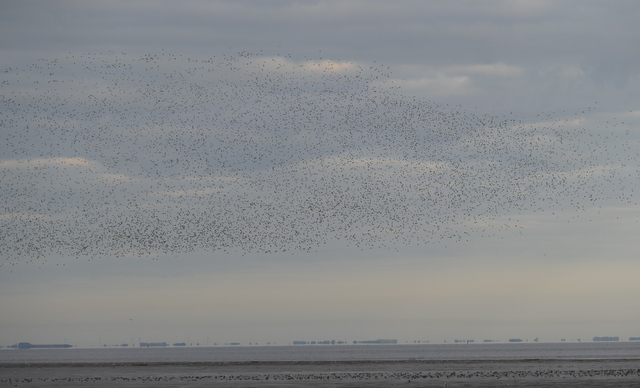




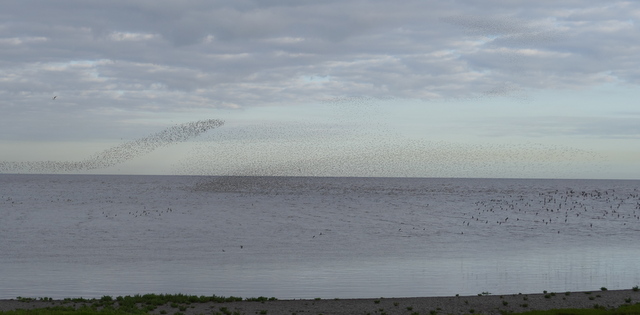
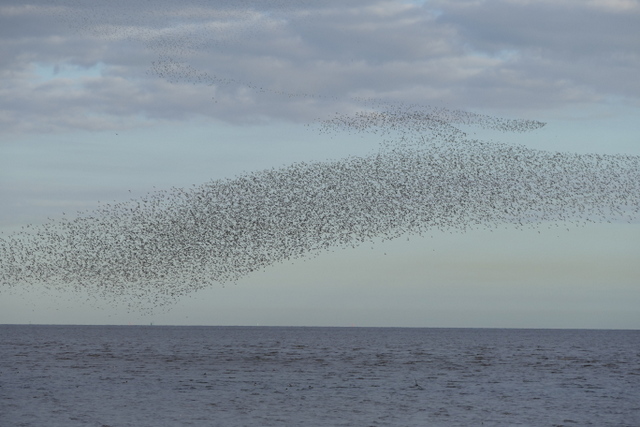

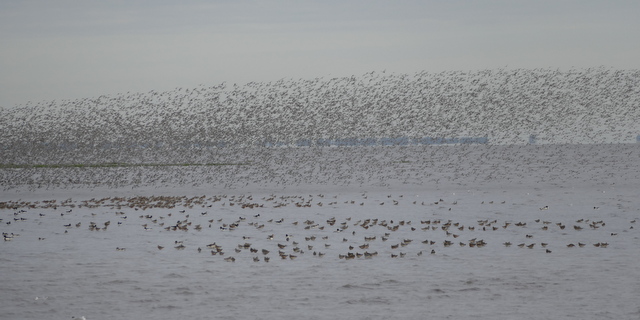
 Wader Spectacular – 60,000+ waders put on a great display this morning
Wader Spectacular – 60,000+ waders put on a great display this morning
As well as the waders, we picked out a couple of other highlights out on the mud. A single Pink-footed Goose looked rather out of place. There are huge flocks of geese here in the winter but the vast majority leave to breed in Iceland. Only the occasional bird, generally sick or injured, remains for the summer. A juvenile Mediterranean Gull flew in and landed amongst the Black-headed Gulls as the water rose.
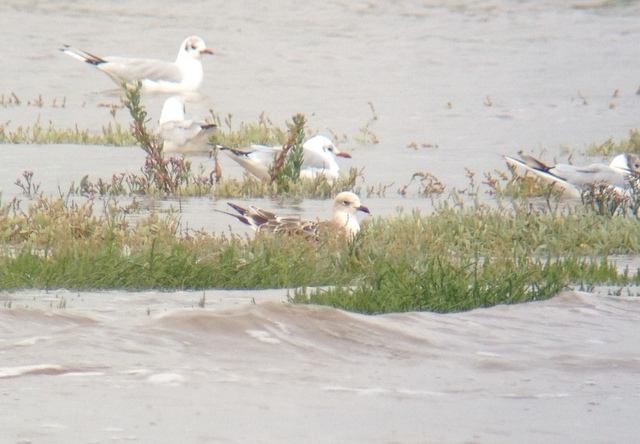 Mediterranean Gull – a scaly brown juvenile
Mediterranean Gull – a scaly brown juvenile
A lot of the waders remained out on the mud today, clustered tightly into a small bay of mud which had not quite been covered by the tide. This was despite the best efforts of the Marsh Harrier to flush them off. There were still several large flocks on the pits and a good opportunity to see some of the different species up close.
There were lots of Common Redshank roosting around the edges and amongst them a good number of Spotted Redshank. There were at least 20 today, in a variety of plumages. Most were now well advanced on their way to winter – silvery grey above and bright white below – but a couple were still much blacker. A single Green Sandpiper flew in to the shore of the shingle bank behind them.
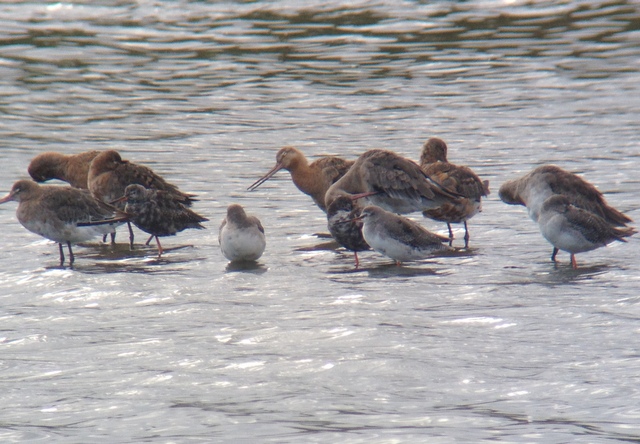 Spotted Redshank – some still sporting remnants of black summer plumage
Spotted Redshank – some still sporting remnants of black summer plumage
On one of the islands, roosting in amongst a large flock of Dunlin and Redshank, a large white bird looked slightly out of place. It was a lone Spoonbill! Eventually it decided it was in the wrong place and flew up to join the roosting Little Egrets on the top of the bank. A Bar-headed Goose was also out of place on the pits amongst the Egyptian Geese and Greylags – an escape from captivity somewhere.
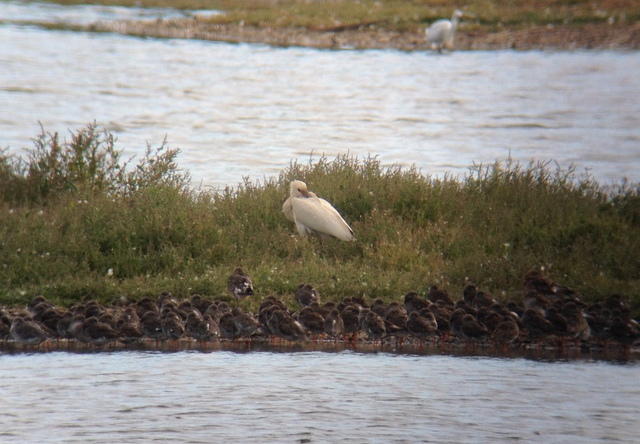 Spoonbill – roosting with the waders at first, looking slightly out of place
Spoonbill – roosting with the waders at first, looking slightly out of place
There are lots of Common Terns breeding on the islands on the pit, and they still have juveniles yet to fledge. Several were flying in and out all morning. A small group were roosting on one of the shingle islands with the waders and a look through revealed a moulting adult Black Tern in amongst them – noticeably smaller, with the remnants of smoky black on its belly.
 Black Tern – this moulting adult was amongst the waders and Common Terns
Black Tern – this moulting adult was amongst the waders and Common Terns
With reports of a Curlew Sandpiper in the roost at the end of the pit, we walked round to South Hide. Unfortunately we couldn’t find it amongst all the Black-tailed Godwits and Dunlin – it had either walked round onto the far side of one of the islands out of view or flown back out to the Wash by the time we got there. Still, we had great views of a Common Sandpiper feeding in amongst the Turnstones in front of the hide.
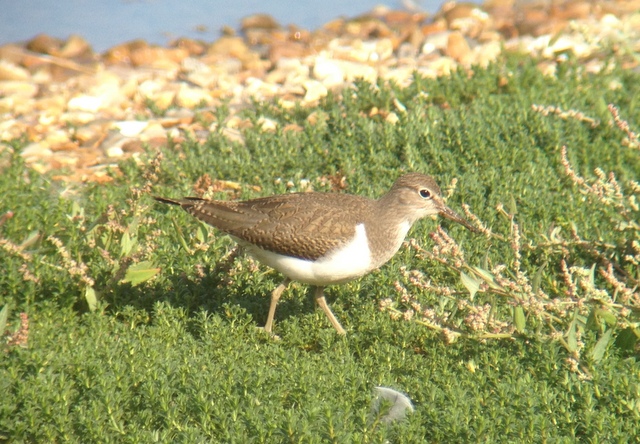 Common Sandpiper – feeding on the pits at over high tide
Common Sandpiper – feeding on the pits at over high tide
About an hour after high tide, we headed back out to look at the flocks still out on the Wash. The tide was going out rapidly and the birds were starting to spread out again, and chase the falling water. A microlight aircraft appeared from the north and flew along the coast while we were there. This was enough to spark pandemonium amongst the roosting flocks and we were treated to another display as they all took to the air and flew round.
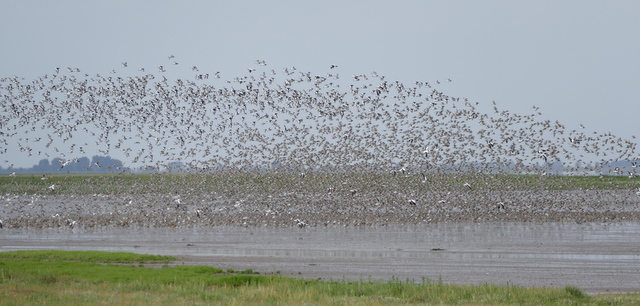 Wader Spectacular – spooked by a microlight as the tide fell again
Wader Spectacular – spooked by a microlight as the tide fell again
There were a few more birds to see as we walked back. Little groups of Meadow Pipits were feeding in the short grass, with a few Pied Wagtails amongst them. A Yellow Wagtail flew over calling and dropped down out into the vegetation of the Wash. Scanning the flocks small waders feeding on the freshly exposed mud, we picked up a single Whimbrel.
We headed round to Titchwell next. Chatting to the volunteers in the shop when we arrived, we learnt that there had been a Wetland Bird Survey count at Snettisham that morning with a total of at least 63,500 birds!
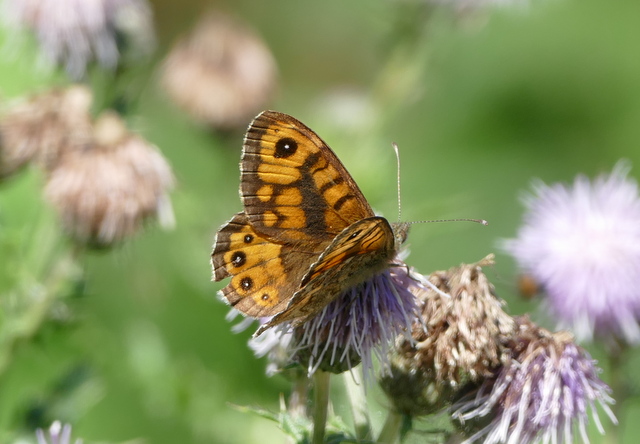 Wall – feeding on thistles along the main footpath
Wall – feeding on thistles along the main footpath
As we walked out along the main path, a Wall butterfly was feeding on the thistles and a couple of Common Darter dragonflies flew around amongst the vegetation. We stopped to look at the reedbed pool on the way. A single female Red-crested Pochard was out amongst the gathering of ducks.
The water levels on the freshmarsh are higher than they were in the week, and there were noticeably fewer waders as a result. It was well after high tide by this stage, but there was still a large flock of Bar-tailed Godwits roosting on the freshmarsh, with a few Knot amongst them. There were also several Turnstones on the island nearby. As we scanned the freshmarsh, we could see small groups of them wake up and fly off towards the beach, until eventually they had all gone.
From Island Hide there were plenty of Ruff, including a very obliging bird feeding right in front of the hide. Most of the birds were adults and mostly now in winter plumage – with scaly grey upperparts and white underparts. The odd bird was still wearing the remnants of summer plumage.
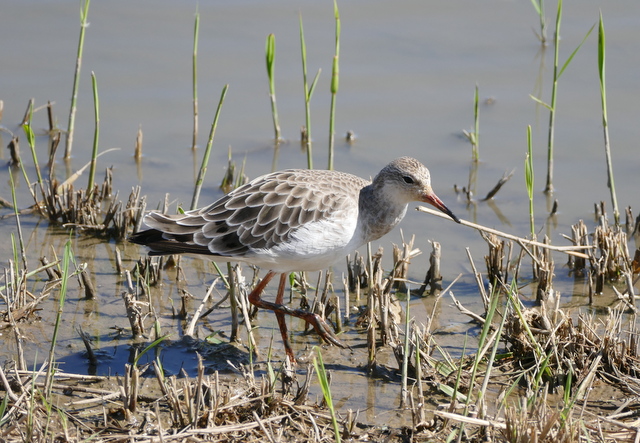 Ruff – a very obliging winter adult from Island Hide
Ruff – a very obliging winter adult from Island Hide
With the higher water levels, the number of Dunlin was well down on recent weeks. There were still a few feeding around the edges of the islands and the remaining mud by the reeds. Most were juveniles, with black spotted bellies, but amongst them we could still find a few adults with the solid black belly patches of summer plumage.
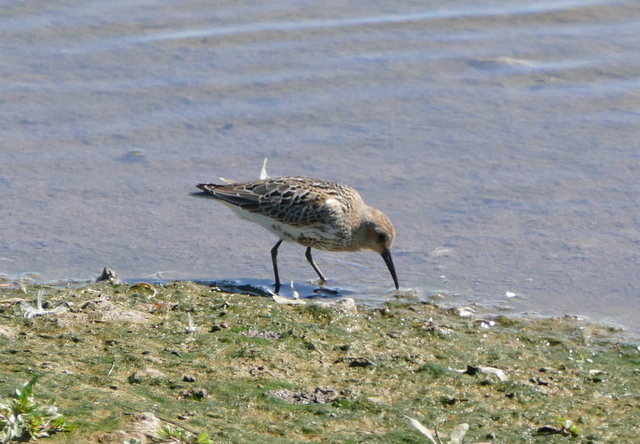 Dunlin – most were juveniles today, with spotted black bellies
Dunlin – most were juveniles today, with spotted black bellies
Number of Avocet also appear to be down, although that is compared to the record number of recent weeks. There was still no shortage of them!
 Avocet – fewer than the recent record numbers today
Avocet – fewer than the recent record numbers today
From round at Parrinder Hide, there was no sign of the Wood Sandpiper today which has been here in recent weeks. A Common Sandpiper was feeding around the island at the back. A juvenile Yellow Wagtail was down on the edge of the water with the Pied Wagtails, though it appeared not to be welcome and one of the Pieds chased it away. We could also see the Spoonbills from here, sleeping at the back of the freshmarsh, behind the vegetation on the largest island. There were ten of them here today.
 Spoonbills – 10 sleeping at the back of the freshmarsh
Spoonbills – 10 sleeping at the back of the freshmarsh
There were more waders on the Volunteer Marsh today. Several summer plumage Grey Plovers were particularly smart, still sporting their black faces and bellies. We paused to admire a Curlew, feeding out on the mud. A couple of Black-tailed Godwits were feeding in the channel right next to the path, giving us great views.
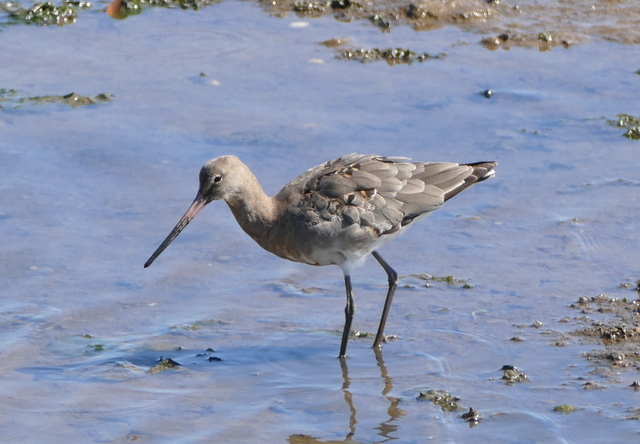 Black-tailed Godwit – feeding in the channel by the path on Volunteer Marsh
Black-tailed Godwit – feeding in the channel by the path on Volunteer Marsh
Out at the beach, we could see a drake Common Scoter standing on the rocks preening, so we headed down for a closer look. We got a great view, able to see clearly the yellow top to the bill.
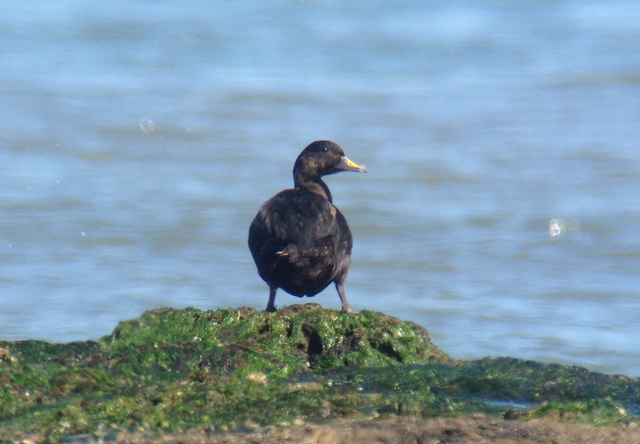 Common Scoter – this drake was preening on the rocks on the beach
Common Scoter – this drake was preening on the rocks on the beach
There was also a good selection of waders now down on the beach. We got great views of the Bar-tailed Godwits in particular, with Oystercatchers, Curlews, Knot and Turnstone also picking around amongst the rock pools. A single Sanderling ran along the beach. A few Sandwich Terns were feeding offshore.
It had certainly been an action-packed morning and it was still only lunchtime! We headed back to the car to get something to eat. Suitably refreshed, we headed round to Patsy’s Reedbed in the afternoon. Apart from lots of moulting Mallard and a family party of Gadwall, there were not as many different ducks here today. A single Common Pochard was the only one of note. There were also at least 5 Little Grebes.
We had thought there might be a few waders here, given the water on the freshmarsh, but at first glance we could only see 3 Ruff. However, a careful scan of the islands revealed a single Common Snipe hiding amongst the vegetation – a nice addition to the day’s wader count.
Along the East Trail, the highlights were mainly insects. There were several Gatekeepers and a single, very faded Meadow Brown. Plus a few Common Darters and Common Blue Damselflies along the path.
 Common Darter – along East Trail this afternoon
Common Darter – along East Trail this afternoon
From round at the end of the Autumn Trail, we scanned the freshmarsh from the other side. Unfortunately the Spoonbills had disappeared – we had hoped for a closer view from here. However, we did find three Spotted Redshanks, one of them still mostly in black summer plumage, together with two Greenshanks, around the back of the island where they were not visible from Parrinder Hide.
A Bearded Tit called and we glimpsed a quick flight view as it flew up from the reeds before dropping straight back in. Despite hearing it call again, unfortunately it did not reappear.
There were no waders on the mud by the reeds in front of us when we arrived, but three juvenile Ruff flew in while we were there. We were just admiring them, when a darker shape appeared out of the reeds behind them – a Water Rail. It walked in and out of the edge of the reeds a couple of times before walking out into the water in the middle of the bay. An odd sight in the middle of a very warm, sunny afternoon! It looked around for a while, nervously, before finally working up the courage to fly across the water to the reeds further along the bank below us.
That seemed a great way to end such an eventful day, so we turned and headed back.
















